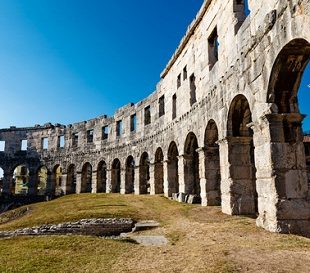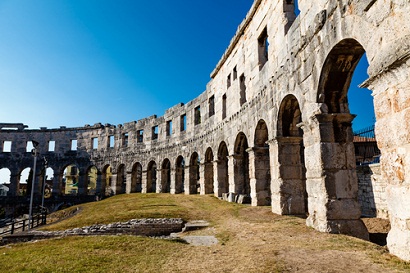
One of the best preserved Roman amphitheatres – Pula amphitheatre
From Chester to Rome, Durres to Nimes, there are just over 200 Roman amphitheatres left in our world in various states of repair. One of the best preserved and sixth largest Roman amphitheatre left on earth for us to enjoy is to be found on the Istrian peninsula in Croatia in the fascinating town of Pula.
Pula lies to the south of this heart shaped peninsula and is the largest town in Istria and the hub of economic activity in the region. In its heyday Pula’s amphitheatre, which is now known as the Pula Arena, held 25,000 spectators compared to 50,000 in Rome’s Coliseum.
This difference is size could be compared to contemporary English football stadiums. Stoke city’s Britannia Stadium, which has a 28,000 capacity, being Pula’s amphitheatre and Manchester City’s Stadium, which has a capacity of 48,000, being comparable to Rome’s Coliseum. Yes, it is safe to surmise that Pula’s grandiose amphitheatre would have been a stadium of English premiership proportions!
Unlike many of the less well preserved amphitheatres of today, Pula is one of the best preserved Roman amphitheatres. The external wall of Pula’s stadium is virtually complete, thus aiding to the exceptional splendour of this truly unique historical site. The ample amount of external space surrounding the building enhances the striking size of the Pula amphitheatre.
Similar to how beautiful white marble was hoisted from Rome’s Coliseum to build the basilica in the Vatican, all of the terracing and seating in Pula’s amphitheatre was pilfered to make houses and other buildings in the town with some of the larger stones ended up as foundations for Venetian palaces.
There are people today who consider this to have been an ancient type of vandalism. From the post-Roman builders’ perspective however, the Roman Empire was dead and buried and the stone blocks were the perfect material for new building projects.
The outer wall of Pula’s amphitheatre is a marvel for sure, and we can only thank our lucky stars that the medieval stonemasons did not get their hands on it.
Whilst there are other Roman buildings in the historical town of Pula, including the triumphal Arch of Sergi, the Gate of Hercules, which dates back to the 1st century BC, and the Temple of Augustus, it’s the Pula Arena, the only remaining Roman amphitheatre to have all three Roman architectural orders to remain entirely preserved, which explicitly demonstrates the architectural finery of Roman amphitheatres.
Why not take a look at Vintage Travel’s collection of luxury villas in Istria?



